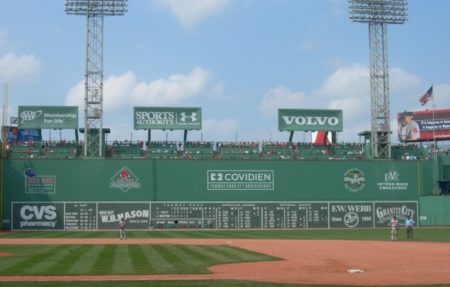Why Are Baseball Traditions Disappearing?
 Baseball Traditions Disappearing
Baseball Traditions Disappearing
Baseball traditions are too few, ephemeral, in danger of change and tied to the holy dollar bill as they convert to the profane.
The gentle valley in left-center field at old Crosley Stadium in Cincinnati. Or the insanely deep left field wall at Forbes Field in Pittsburgh. Even the exterior white walls at Comiskey Field in Chicago left an impression on me.
Then there was the u-shaped Polo Grounds in New York across the Harlem River from Yankee Stadium in the Bronx. It featured a never-ending center-field wall, about a mile further than Yankee Stadium’s center field, or so it seemed. Ask Willie Mays.
The Polo Grounds went on to become the home of the 1962 New York Mets’ and their tradition-rich 120-loss season. A season all bad seasons can be measured against. What would we do without the 1962 Mets? Without baseball traditions?
Then there were the raucous crowds at Ebbets Field in Brooklyn that still resonate through the borough late at night, especially if you stand out on the corner of Empire Boulevard and Bedford Avenue, and listen closely for their unbridled elation. Even though it’s 61 years later. Now that’s tradition, and baseball found a way to kill it for a few more bucks. Although in fairness, Robert Moses shoved Walter O’Malley hard, until he stole his Dodgers across the continent.
Only the Boston-Yankees rivalry has been better than the Dodgers-Yankees of the ’50s. Now legendary. A rivalry baseball hungers for today. Great teams that claw at each other’s hearts. Regularly. Games that mean something to the fans. You see, when the games are great, limiting visits to the mound and pitch clocks are unnecessary. Because the drama is so compelling.
Today, these competitive battles have to be manufactured and hyped to lure in viewers bored by long lapses without action. Used to 30-45 seconds of boredom between football plays, many fans lose interest during the four minute wait between actions of a baseball game. So, colorful videos are spiked with the promise of faux excitement, with Manny Machado or Aaron Judge or Mookie Betts highlighted, as if they’re quarterbacks running the offense. Rivalry is history. And history is full of unanticipated characters who came through in the clutch. Not necessarily the superstars. This is the stuff of baseball tradition.
Larry Sherry. Donn Clendenin. Gene Tenace. Rick Dempsey. And the most recent understudy, Steve Pearce, who burst to national prominence out of the shadows, swatting home runs out of nowhere. Yankee fans know he was the force that changed the Eastern Division race this past August when he almost single-handedly homered the Yankees into submission. And then he did the same to the Dodgers. What will he do for an encore?
The Physical Elements of Baseball Tradition
Not as ephemeral. Every stadium has its peculiarities. The Green Monster in Fenway Park, the hulking scoreboard in center field at Wrigley Field and, of course, the ivy on the outfield walls. These accoutrements enhance the baseball experience. The way the old monuments did in Yankee Stadium.
Not that Memorial Stadium was a great place to see a game, it was never Fenway Park, but it was a baseball field that Camden Yards papered over with expensive eccentricities. Great championship teams called Memorial Stadium home, regardless of its simplicities.
Whereas Monument Park in Yankee Stadium was a shrine devoted to some of the Yankee greats over the years, placed to the left of the 461 foot sign in center field. So far from home plate that the headstones hardly ever interfered with play.
Though, I was at a game at the old Yankee Stadium in the mid-1960s when the always dangerous Minnesota Twins slugger, Harmon Killebrew, swatted a mammoth blast, a home run anywhere else in baseball, but at Yankee Stadium his blast needed several prodigious bounces to reach the monuments before settling behind one as Killebrew lumbered into third with a triple.
There are no longer any monuments on the field. And haven’t been since the fences were moved in during the Yankees brief and ignominious stay at Shea Stadium in the early 1970s when Yankee Stadium was renovated. Anyone remember Elliott Maddux?
There was something beautiful about seeing those monuments on the field. Something connected to the days when fans could walk on the field after a game. And fans could sit in foul territory to view a game, way back during baseball’s earliest days. These baseball traditions are long gone now.
Thank goodness the Green Monster of Fenway is still one of the mainstays of baseball. Hearing that loud metallic clang as the horsehide smacks into the wall is a one of the great echoes of baseball’s past.
While there is no Green Monster at Wrigley Field, the other remaining temple of the game, there is the wonderful specter of the antiquated center-field scoreboard daring anyone to take a 500 to 600 foot shot at it (as Paul Sullivan of the Chicago Tribune recently wrote about, calling it the last frontier of Wrigley Field). At least the ivy-laden brick outfield walls are more easily accessible than the scoreboard. These are the sacred grounds of baseball. Problem is, there’s less and less of them with every old stadium torn down.
The Argument
By diluting traditions, baseball has harmed its brand. New stadiums were unnecessarily planned to replace older ones so ownership could raise prices, create more high-priced luxury seating and corporate suites. Today, there is even tiered pricing so teams can charge more to view the best teams, and lesser prices to see the ordinary ones.
Add to that, players, once the bedrock of a team’s identity, are now moved around more than ever, and more often than not because of price. Their asking price. So, a player could be traded to improve a team, although not all trades achieve their purpose.
Tom Seaver was traded in June 1977 as a result of a contractual dispute with the Mets. At the time, Seaver was in his age-32 season, and though he would be a good pitcher another 10 seasons, he would never be the Seaver of 1967-1977. So, the Mets made a business decision to resist Seaver’s demands, but the trade was one of the worst in franchise history (and that was saying something indeed, given the way they donated Nolan Ryan to the California Angels’ cause in 1971) since they got nothing of any value back from Cincinnati.
Pat Zachary, Doug Flynn, Steve Henderson and Dan Norman comprised the haul. Zachary and Flynn were average, at best, major league players for the Mets, while the other two were career minor leaguers. This is yet one more chapter in the sorry past of New York Mets’ history, for those who remember how wonderful Seaver was those first 10 seasons at Shea Stadium. And then how bad the team was after his departure.
If you want to experience baseball as it might have been played in the early 1900s, McCoy Stadium in Pawtucket Rhode Island, where the Triple-A Pawtucket Red Sox play, exudes a turn of the 20th century charm, or is it minimalism? Even though it was built in 1946. The idea of a cavernous temple built to accommodate the roving mind, the fan who comes to the ballpark to see more than the game, was not in vogue 80 years ago.
Sit in the stands at McCoy, or traverse the narrow aisles in the guts of the stadium, and you may feel baseball traditions come alive as if Ty Cobb or Honus Wagner or Christy Mathewson was about to hurry past onto the field ready to play the game rough and tough. Spikes up. Not nice and pretty.
But in These New Amusement Parks . . .
The baseball game is secondary. Content. Not the focus it was when the game was the game. These ballparks are so spacious on the inside that leaving your seat is no longer the bore it once was when only food stands (the same everywhere in the stadium) and bathrooms were the only attractions.
Institutions are sacred for a reason. We depend on them to order our lives. What will baseball be like when Fenway and Wrigley Field are gone? What will we be like? Or will the next Fenway Park be like the new Yankee Stadium, almost identical on the field and a Times Square on the inside?
Pretending to showcase baseball. Can baseball survive this?






















